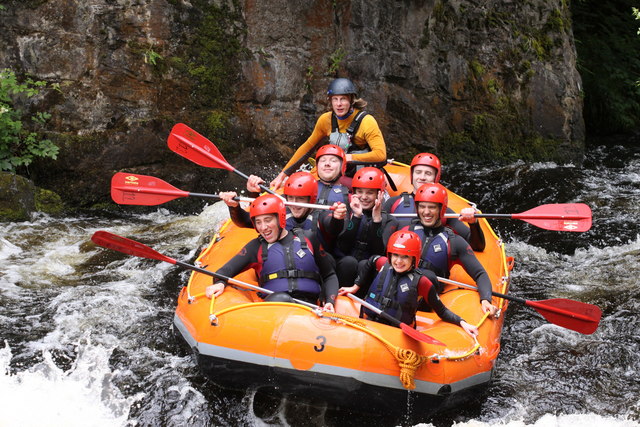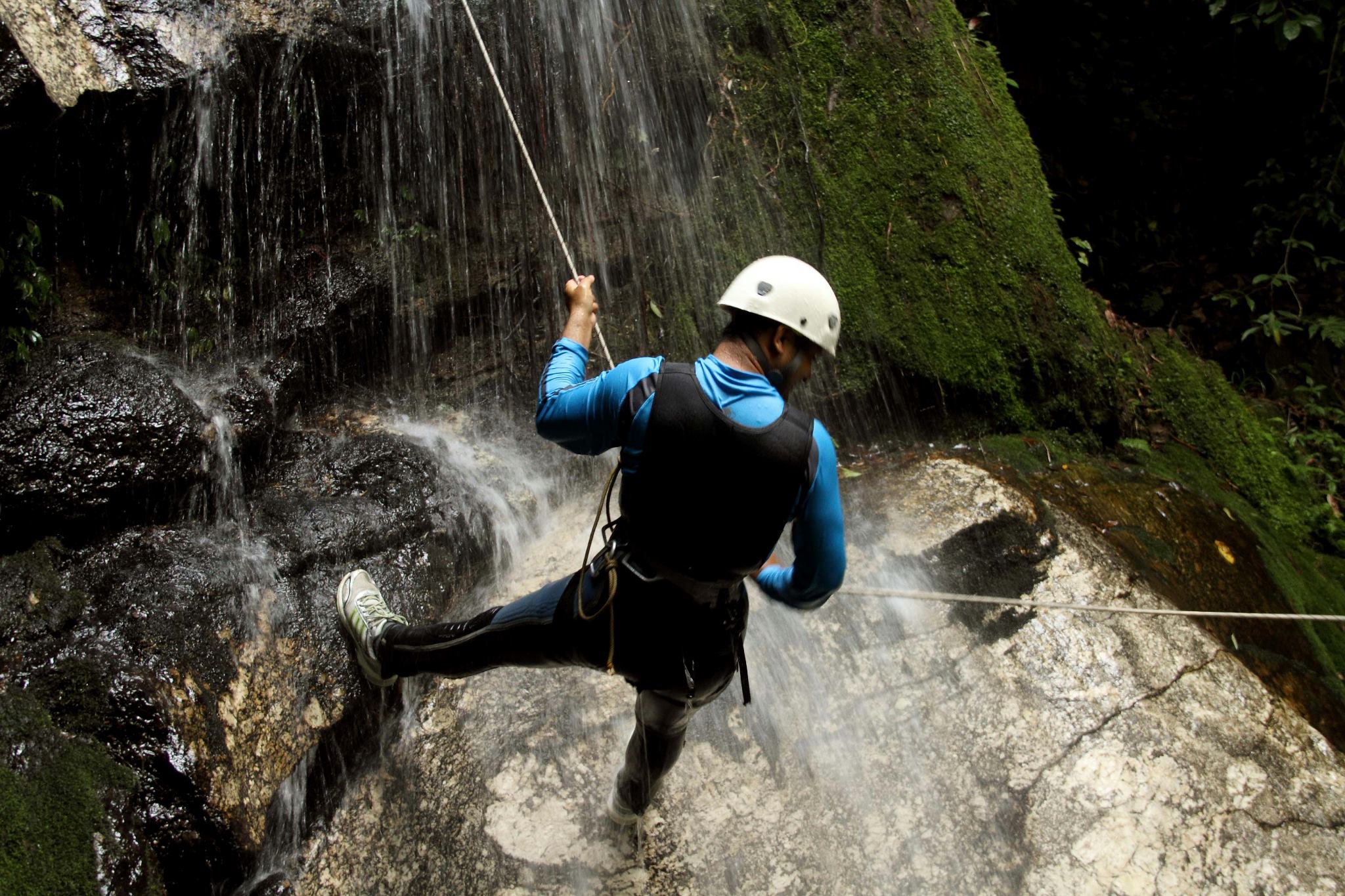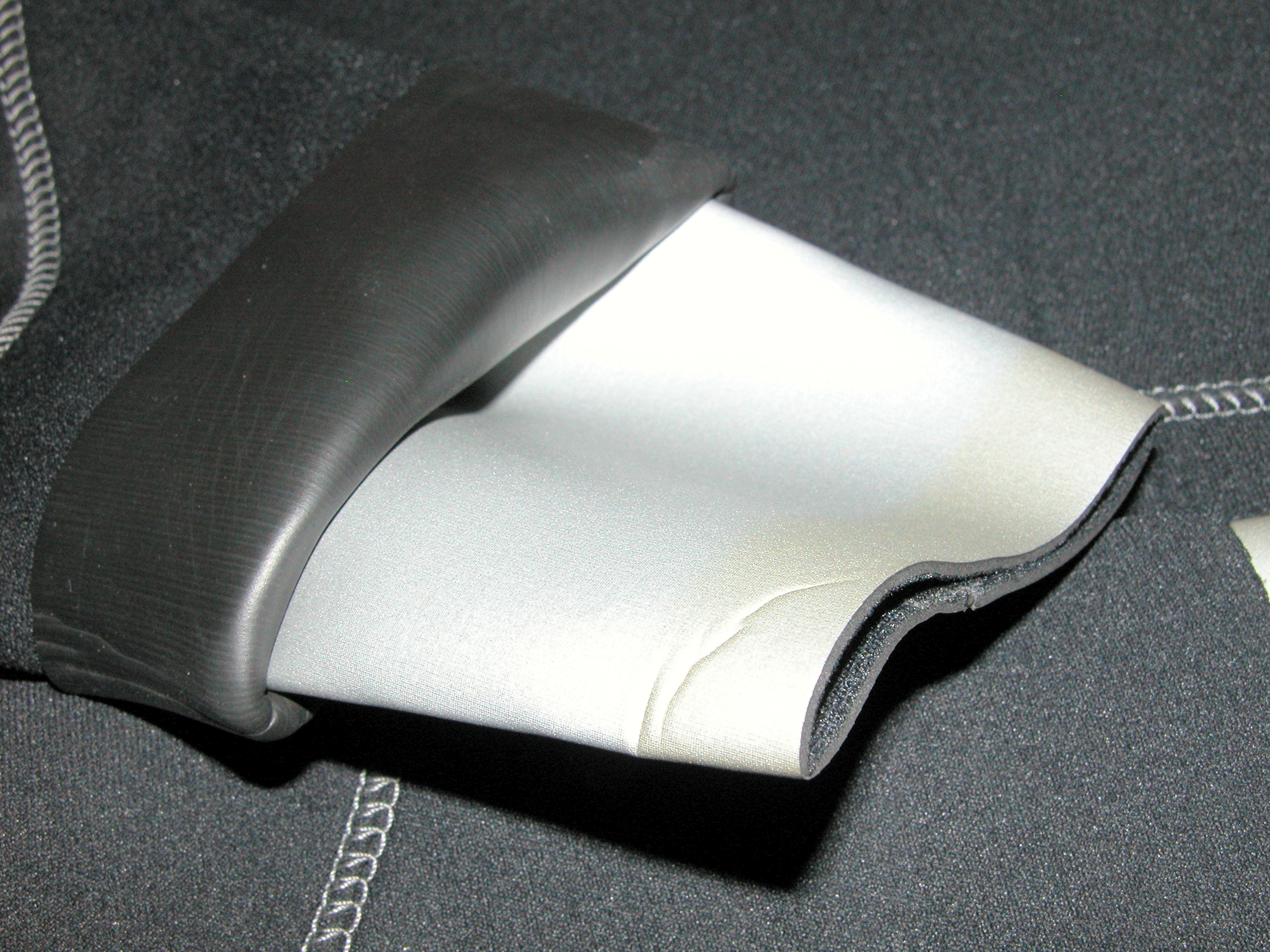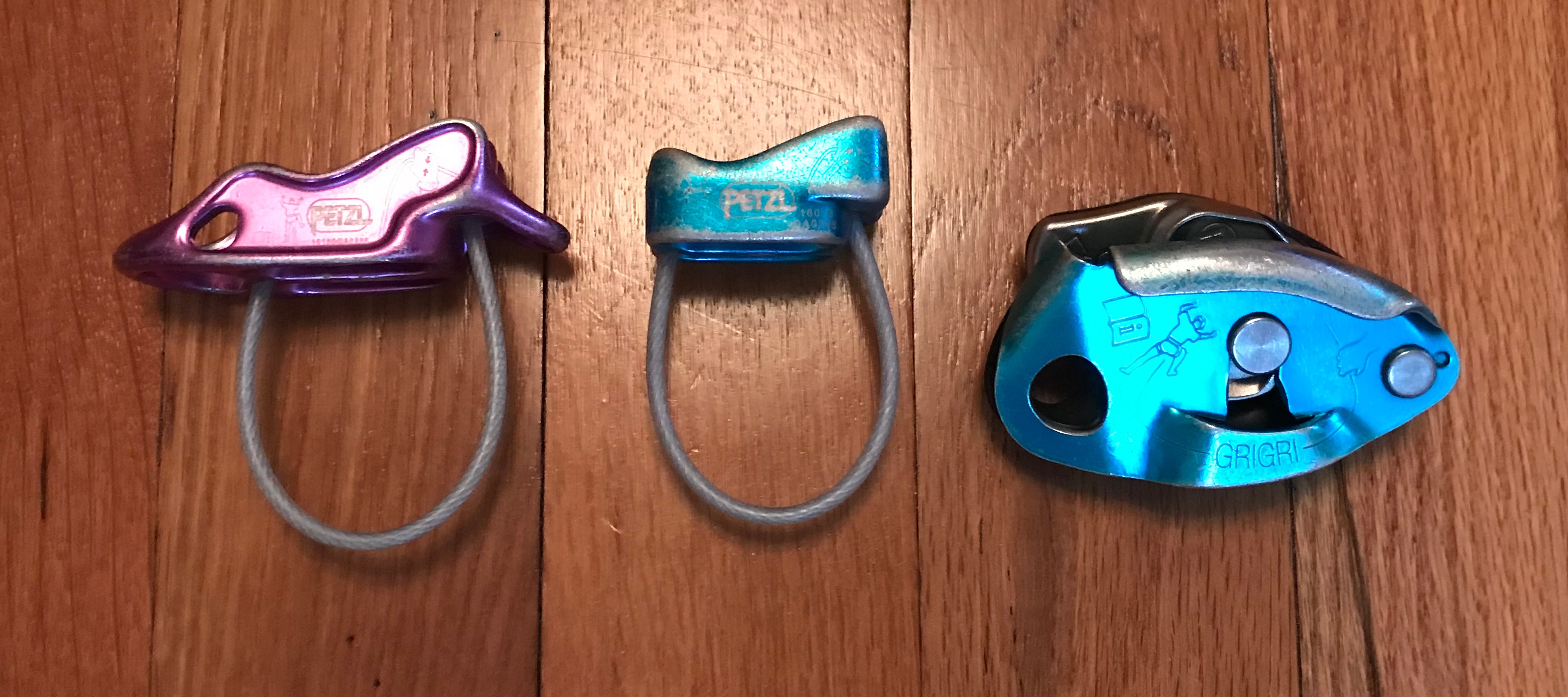|
Kloofing
Kloofing is an adventure activity that typically involves the descent of a deep ravine or watercourse that may be dry or wet. The defining factor is usually that the ravine is several times deeper than it is wide. All manner of walking, scrambling, climbing, swimming, plunging, jumping, bumslides or abseiling (rappelling) could be involved. A kloofing trip usually combines hiking with the descent of a watercourse. Some of the more "interesting" kloofing involves long abseils or high jumps into pools from varying heights, up to as high as 20 or more metres (for example the popular 'Suicide Gorge' in South Africa). Kloofing trips can take from as short as a few hours up to multi-day kloofing trips that would require a party to overnight in a ravine. Depending on the nature of a particular trail a kloofer (noun) might require specialised technical equipment such as a rope, belay device, wetsuit, rock climbing anchors, etc. Every year a number of kloofers get injured or need rescu ... [...More Info...] [...Related Items...] OR: [Wikipedia] [Google] [Baidu] |
Adventure
An adventure is an exciting experience or undertaking that is typically bold, sometimes risky. Adventures may be activities with danger such as traveling, exploring, skydiving, mountain climbing, scuba diving, river rafting, or other extreme sports. Adventures are often undertaken to create psychological arousal or in order to achieve a greater goal, such as the pursuit of knowledge that can only be obtained by such activities. Motivation Adventurous experiences create psychological arousal, which can be interpreted as negative (e.g. fear) or positive (e.g. flow (psychology), flow). For some people, adventure becomes a major pursuit in and of itself. According to adventurer André Malraux, in his ''Man's Fate'' (1933), "If a man is not ready to risk his life, where is his dignity?". Similarly, Helen Keller stated that "Life is either a daring adventure or nothing." Outdoor adventurous activities are typically undertaken for the purposes of recreation or wikt:excitement, excite ... [...More Info...] [...Related Items...] OR: [Wikipedia] [Google] [Baidu] |
South Africa
South Africa, officially the Republic of South Africa (RSA), is the southernmost country in Africa. It is bounded to the south by of coastline that stretch along the South Atlantic and Indian Oceans; to the north by the neighbouring countries of Namibia, Botswana, and Zimbabwe; and to the east and northeast by Mozambique and Eswatini. It also completely enclaves the country Lesotho. It is the southernmost country on the mainland of the Old World, and the second-most populous country located entirely south of the equator, after Tanzania. South Africa is a biodiversity hotspot, with unique biomes, plant and animal life. With over 60 million people, the country is the world's 24th-most populous nation and covers an area of . South Africa has three capital cities, with the executive, judicial and legislative branches of government based in Pretoria, Bloemfontein, and Cape Town respectively. The largest city is Johannesburg. About 80% of the population are Black South Afri ... [...More Info...] [...Related Items...] OR: [Wikipedia] [Google] [Baidu] |
Canyoneering
Canyoning (canyoneering in the United States, kloofing in South Africa) is a type of mountaineering that involves travelling in canyons using a variety of techniques that may include other outdoor activities such as walking, scrambling, climbing, jumping, abseiling (rappelling), and swimming. Although non-technical descents such as hiking down a canyon (''canyon hiking'') are often referred to as ''canyoneering'', the terms ''canyoning'' and ''canyoneering'' are more often associated with technical descents — those that require abseils (rappels) and ropework, technical climbing or down-climbing, technical jumps, and/or technical swims. Canyoning is frequently done in remote and rugged settings and often requires navigational, route-finding, and other wilderness travel skills. Canyons that are ideal for canyoning are often cut into the bedrock stone, forming narrow gorges with numerous drops, beautifully sculpted walls, and sometimes spectacular waterfalls. Most can ... [...More Info...] [...Related Items...] OR: [Wikipedia] [Google] [Baidu] |
Canyoning
Canyoning (canyoneering in the United States, kloofing in South Africa) is a type of mountaineering that involves travelling in canyons using a variety of techniques that may include other outdoor activities such as walking, scrambling, climbing, jumping, abseiling (rappelling), and swimming. Although non-technical descents such as hiking down a canyon (''canyon hiking'') are often referred to as ''canyoneering'', the terms ''canyoning'' and ''canyoneering'' are more often associated with technical descents — those that require abseils (rappels) and ropework, technical climbing or down-climbing, technical jumps, and/or technical swims. Canyoning is frequently done in remote and rugged settings and often requires navigational, route-finding, and other wilderness travel skills. Canyons that are ideal for canyoning are often cut into the bedrock stone, forming narrow gorges with numerous drops, beautifully sculpted walls, and sometimes spectacular waterfalls. Most canyo ... [...More Info...] [...Related Items...] OR: [Wikipedia] [Google] [Baidu] |
Africa
Africa is the world's second-largest and second-most populous continent, after Asia in both cases. At about 30.3 million km2 (11.7 million square miles) including adjacent islands, it covers 6% of Earth's total surface area and 20% of its land area.Sayre, April Pulley (1999), ''Africa'', Twenty-First Century Books. . With billion people as of , it accounts for about of the world's human population. Africa's population is the youngest amongst all the continents; the median age in 2012 was 19.7, when the worldwide median age was 30.4. Despite a wide range of natural resources, Africa is the least wealthy continent per capita and second-least wealthy by total wealth, behind Oceania. Scholars have attributed this to different factors including geography, climate, tribalism, colonialism, the Cold War, neocolonialism, lack of democracy, and corruption. Despite this low concentration of wealth, recent economic expansion and the large and young population make Afr ... [...More Info...] [...Related Items...] OR: [Wikipedia] [Google] [Baidu] |
English Language
English is a West Germanic language of the Indo-European language family, with its earliest forms spoken by the inhabitants of early medieval England. It is named after the Angles, one of the ancient Germanic peoples that migrated to the island of Great Britain. Existing on a dialect continuum with Scots, and then closest related to the Low Saxon and Frisian languages, English is genealogically West Germanic. However, its vocabulary is also distinctively influenced by dialects of France (about 29% of Modern English words) and Latin (also about 29%), plus some grammar and a small amount of core vocabulary influenced by Old Norse (a North Germanic language). Speakers of English are called Anglophones. The earliest forms of English, collectively known as Old English, evolved from a group of West Germanic (Ingvaeonic) dialects brought to Great Britain by Anglo-Saxon settlers in the 5th century and further mutated by Norse-speaking Viking settlers starting in the 8th and 9th ... [...More Info...] [...Related Items...] OR: [Wikipedia] [Google] [Baidu] |
Afrikaans Language
Afrikaans (, ) is a West Germanic languages, West Germanic language that evolved in the Dutch Cape Colony from the Dutch dialects, Dutch vernacular of Holland, Holland proper (i.e., the Hollandic dialect) used by Dutch, French, and German settlers and Slavery in South Africa, their enslaved people. Afrikaans gradually began to develop distinguishing characteristics during the course of the 18th century. Now spoken in South Africa, Namibia and (to a lesser extent) Botswana, Zambia, and Zimbabwe, estimates circa 2010 of the total number of Afrikaans speakers range between 15 and 23 million. Most linguists consider Afrikaans to be a partly creole language. An estimated 90 to 95% of the vocabulary is of Dutch origin with adopted words from other languages including German language, German and the Khoisan languages of Southern Africa. Differences between Afrikaans and Dutch, Differences with Dutch include a more analytic language, analytic-type Morphology (linguistics), morphology ... [...More Info...] [...Related Items...] OR: [Wikipedia] [Google] [Baidu] |
Rock Climbing
Rock climbing is a sport in which participants climb up, across, or down natural rock formations. The goal is to reach the summit of a formation or the endpoint of a usually pre-defined route without falling. Rock climbing is a physically and mentally demanding sport, one that often tests a climber's strength, endurance, agility and balance along with mental control. Knowledge of proper climbing techniques and the use of specialized climbing equipment is crucial for the safe completion of routes. Because of the wide range and variety of rock formations around the world, rock climbing has been separated into several different styles and sub-disciplines, such as scrambling, bouldering, sport climbing, and trad (traditional) climbing another activity involving the scaling of hills and similar formations, differentiated by the rock climber's sustained use of hands to support their body weight as well as to provide balance. Rock climbing competitions have the objectives of either ... [...More Info...] [...Related Items...] OR: [Wikipedia] [Google] [Baidu] |
Wetsuit
A wetsuit is a garment worn to provide thermal protection while wet. It is usually made of foamed neoprene, and is worn by surfing, surfers, Underwater diving, divers, windsurfers, canoeists, and others engaged in water sports and other activities in or on water. Its purpose is to provide thermal insulation and protection from abrasion (medical), abrasion, ultraviolet exposure, and stings from marine organisms. It also contributes extra buoyancy. The insulation properties of neoprene foam depend mainly on bubbles of gas enclosed within the material, which reduce its ability to Conduction (heat), conduct heat. The bubbles also give the wetsuit a low density, providing buoyancy in water. Hugh Bradner, a University of California, Berkeley physicist, invented the modern wetsuit in 1952. Wetsuits became available in the mid-1950s and evolved as the relatively fragile foamed neoprene was first backed, and later sandwiched, with thin sheets of tougher material such as nylon or later ... [...More Info...] [...Related Items...] OR: [Wikipedia] [Google] [Baidu] |
Belay Device
A belay device is a mechanical piece of climbing equipment used to control a rope during belaying. It is designed to improve belay safety for the climber by allowing the belayer to manage their duties with minimal physical effort. With the right belay device, a small, weak climber can easily arrest the fall of a much heavier partner. Belay devices act as a friction brake, so that when a climber falls with any slack in the rope, the fall is brought to a stop. Typically, when the rope is held outward, away from the body, it moves relatively freely, so the belayer can take up or pay out slack. When the rope is brought backward, to the side of the body, the rope is forced into tight bends and rubs against the device and/or against itself, allowing the belayer to arrest the descent of a climber in the case of a fall. This rubbing slows the rope, but also generates heat. Some types of belay devices can arrest a fall without the belayer taking any action, while others require the belayer ... [...More Info...] [...Related Items...] OR: [Wikipedia] [Google] [Baidu] |
Rope
A rope is a group of yarns, plies, fibres, or strands that are twisted or braided together into a larger and stronger form. Ropes have tensile strength and so can be used for dragging and lifting. Rope is thicker and stronger than similarly constructed cord, string, and twine. Construction Rope may be constructed of any long, stringy, fibrous material, but generally is constructed of certain natural or synthetic fibres. Synthetic fibre ropes are significantly stronger than their natural fibre counterparts, they have a higher tensile strength, they are more resistant to rotting than ropes created from natural fibres, and they can be made to float on water. But synthetic ropes also possess certain disadvantages, including slipperiness, and some can be damaged more easily by UV light. Common natural fibres for rope are Manila hemp, hemp, linen, cotton, coir, jute, straw, and sisal. Synthetic fibres in use for rope-making include polypropylene, nylon, polyesters (e.g. ... [...More Info...] [...Related Items...] OR: [Wikipedia] [Google] [Baidu] |
Abseil
Abseiling ( ; ), also known as rappelling ( ; ), is the controlled descent of a steep slope, such as a rock face, by moving down a rope. When abseiling the person descending controls their own movement down the rope, in contrast to lowering off in which the rope attached to the person descending is paid out by their belayer. This technique is used by climbers, mountaineers, cavers, canyoners, search and rescue and rope access technicians to descend cliffs or slopes when they are too steep and/or dangerous to descend without protection. Many climbers use this technique to protect established anchors from damage. Rope access technicians also use this as a method to access difficult-to-reach areas from above for various industrial applications like maintenance, construction, inspection and welding. To descend safely, abseilers use a variety of techniques to increase the friction on the rope to the point where it can be controlled comfortably. These techniques range f ... [...More Info...] [...Related Items...] OR: [Wikipedia] [Google] [Baidu] |








